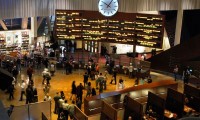As I was saying…
THE HOBBIT: THE DESOLATION OF SMAUG: Worth A Ticket – The Long Road Continues, But This Time On A Better Path
Jumping at once to the most pressing matter–which is more than its trilogy often does–Peter Jackson’s THE HOBBIT: THE DESOLATION OF SMAUG is considerably more enjoyable than last year’s monument to bloat An Unexpected Journey, although still not in a league with his classic Lord of the Rings trilogy. (Similarly, the series’ much-vaunted and somewhat controversial High Frame Rate presentation proves itself improved but not yet perfected.)
Smaug, of course, has the advantage over Journey in that the initial burden of exposition is already behind it. We’ve met the thirteen dwarves, led by Thorin Oakenshield (Richard Armitage), who are on a mission with Bilbo Baggins (Martin Freeman) and Gandalf (Ian McKellan) to the Lonely Mountain, which was once a dwarf kingdom of treasure ruled by Thorin’s ancestors, but is now the domain of the fearsome dragon Smaug (voiced and performed via motion-capture by Benedict Cumberbatch); Bilbo’s task is to steal the magical Arkenstone jewel from Smaug, which will (somehow) enable Thorin to regain his throne. With all that underway, Smaug can make the most of its bulk of the action sequences contained in J.R.R. Tolkien’s novel, which Jackson has stepped up to a state-of-the-technology, fantastically-expensive CG level. Having escaped trolls and goblins the last time around, Smaug gives us a zillion orcs and wargs and some less-than-friendly elves, not to mention great Smaug himself.
This is by far the most “action movie” of any of the Tolkien films, and there are times that it can feel like a Pirates of the Caribbean-ish set-up for theme park attractions, most notably in an epic escape via barrel from the orcs and elves, featuring a sequence so insanely acrobatic that it’s gasp-inducing, although also so flagrantly impossible in its physiology that one ends up appreciating the CG artists who created it more than anything else. (Similarly, the orcs are so easily slaughtered and in such numbers that they could as well be minor figures in video games.) But compared to Journey, this script, again by Jackson, Fran Walsh, Philippa Boyens and Guillermo del Toro, is also a much more character-based chapter, with time spent not only with Bilbo and several of the individual dwarves, but with elves Legolas (Orlando Bloom) and steely newcomer Tauriel (Evangeline Lilly), as well as human boatman/marksman Bard (Luke Evans) in his small town. (Tauriel is the first prominent character invented solely for the movies, and she’s a lot of fun, although more in a Katniss Everdeen way than a Tolkien one.) All this effort pays off, as it’s a lot easier to care about the events in this installment.
Jackson couldn’t drag Gollum back this time, but he doesn’t let many minutes go by without reminding us of that fateful ring Bilbo is now carrying around with him. The strenuous attempts to tie the Hobbit series in with Lord of the Rings and raise the stakes for a story that, on its own, hardly deserves an 8-9 hour trilogy, are sometimes exhausting and overly familiar, most notably in a lengthy detour Gandalf makes for a pit-stop with ultimate evil that feels like an outtake from the earlier trilogy. The climactic showdown with Smaug, while spectacular enough for anyone and a triumph of CG and motion-capture (as well as the silky evil in Cumberbatch’s voice and computer-translated movements), also feels a bit second-hand, indebted to other movies about dragons and similar monstrous beasts. But then, in the fifth feature of a double-trilogy, it must be hard to find much in this Middle-Earth that wouldn’t feel second-hand. The cliffhanger ending, unlike the ones at the end of the other Tolkien chapters, feels forced, as though Warner Bros wanted to make sure no one would dare fail to buy a ticket for the next one.
Thanks to the more intimate focus of the drama, some of the actors get to shine here as they didn’t in Journey, with particular highlights for Freeman’s increasingly heroic Bilbo, Armitage, Aidan Turner as the dwarf Kili, Evans and Lilly. Jackson and his army of technicians have, as always, delivered a skull-blowing visual and aural package. Much of the story has been shot by Andrew Lesnie in a desaturated color scheme, which apart from often being quite lovely and atmospheric, works well with the High Frame Rate presentation. The state of HFR right now seems to be that as long as the lighting is kept fairly low, the images have the precision and detail that Jackson prizes, along with superb 3D effect. However, in bright light, whether sunshine or otherwise, the “videotape” look of the technology reappears, and the fakeness of CG effects, sets and make-up becomes all too evident. In one stretch of Smaug that intercuts between actions taking place in settings of light and shadow, it was distractingly as though the picture was switching media from shot to shot. The gigantic production design by Dan Hennah and sound design are worthy of special appreciation, as is the latest selection from Howard Shore’s continuing epic score. The editing by Jabez Olssen is, mercifully, less stately than it was in the first chapter.
When An Unexpected Journey ended, it was hard not to dread half a dozen more hours spent on the road to Lonely Mountain, but THe Desolation of Smaug shows Peter Jackson to have absorbed the lessons of that misfire. Despite all his mighty efforts, Smaug just doesn’t have the weight or power of Lord of the Rings–really, given the differences in source material, how could it?–but it’s a full-bore holiday entertainment that stints on nothing as it spins its tale.




